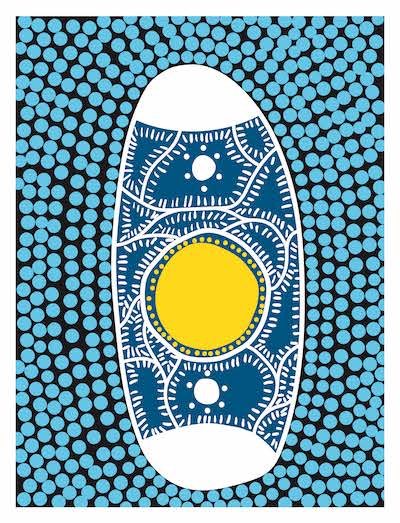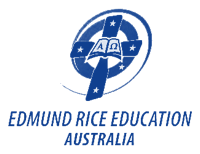
Left: Photograph of Fr Aloysius Fitzgerald OFM. Right: The restored painting.
by Kim Eberhard, Archivist
In 2015 two pieces of the Waverley College Art Collection were restored. Both are portraits of significant – if perhaps not so well known – figures in the history of the College, Fr Aloysius Fitzgerald OFM and General John A Chapman. Investigating the provenance of each image has revealed a number of connections and relationships, which have enriched the story of the College and its people.
Fr T A Fitzgerald OFM
Fr Aloysius Fitzgerald was a Franciscan priest in charge of the Waverley parish in 1902. As Provincial of the Order, he was responsible for inviting the Christian Brothers to Waverley to teach at the schools throughout the Parish, which at that time included not only St Charles’ on Carrington Rd, but extended as far as St Francis’ in Paddington and St Joseph’s at Edgecliff. Himself a former student of the Christian Brothers in Ireland, Fr Fitzgerald was well aware of the value of having a Christian Brothers’ presence in Waverley. He was instrumental in the purchase of Airmount, the building in which Waverley College was started in 1903. Fr Fitzgerald came to Sydney in 1886 as part of the second group of Franciscans to arrive from Ireland. Known as an exceptionally gifted man, he was remembered as a brilliant public speaker, a linguist, a writer of stories and books, and for his talent for friendships, which included Cardinal Moran and a number of up-and-coming artists. Fitzgerald returned to Ireland in 1905, but came back to Sydney once again in 1920 to serve within Waverley parish. He was welcomed ‘home’ at a reception at Waverley College on 5 February that year, at which all of the students, as well as many Old Boys, celebrated his return.
In responding, Fr Fitzgerald expressed the happiness it gave him to see so many boys present. He looked back with pleasure to the small beginning he had made over 17 years ago in purchasing the little plot of land and the place then called ‘Airmount’.
In responding, Fr Fitzgerald expressed the happiness it gave him to see so many boys present. He looked back with pleasure to the small beginning he had made over 17 years ago in purchasing the little plot of land and the place then called ‘Airmount’.

Waverley College students at the reception for Fr Fitzgerald, 5 February 1920.
Edward M Smith
Our portrait of Fr Aloysius Fitzgerald OFM was painted by Edward M Smith. Artist and teacher, Smith was one of several visiting specialists employed by the College to augment the subjects on offer for the students. Edward Smith was also a close friend of Fr Fitzgerald, who sat for him as the subject of one of Smith’s works; the resulting portrait was later gifted to the College in 1915. In the late 1930s, Smith became the art critic for the Daily Telegraph in addition to his teaching role at East Sydney Technical College. He also conducted private lessons. In this later capacity he taught Justin O’Brien, who had been a student at Waverley College in the 1920s-1930s, where it is likely the two first met. O’Brien went on to have a significant career, winning the inaugural Blake Prize for Religious Art in 1951, and receiving commissions from all over the world. He lived for many years in Rome. O’Brien’s career spanned five decades, with his work held in private collections and Australian and international galleries. He was well known for the religious imagery in his work, which many attribute to the influences he first studied under Edward Smith.

Edward M Smith, Artist and Teacher, 1919
John A Chapman
The second piece of art restored is a hand-coloured photographic portrait of Brigadier-General John Austin Chapman, after whom the College’s highest Cadet Award is named. John and his brother James both attended Waverley College between 1909 and 1913, when they left to pursue military careers through the Royal Military College, Duntroon. Both men served in both World Wars, and were both decorated with military and civilian honours. In 1942, the year after the Waverley College Cadet Corps was re-established after its demise in the late 1920s, the then Major-General John Chapman visited the school, in particular to lend support to the cadets. The first Passing Out Parade was held in 1942, a ceremony that ended with the first presentation of the Chapman award. The Annual of that year makes the following note:
Perhaps the event of deepest personal interest for the corps was the visit of the school’s most distinguished soldier, Major-General J A Chapman. In a simple but imposing ceremony he took the salute and then addressed us briefly and inspiringly on the significance of our work. The year’s activities were fittingly brought to a conclusion by the ‘Passing Out Parade’ held for the first time this year. … The function was also a pleasant social one, the parents and friends being invited and entertained by the cadets to afternoon tea in the College dining room. During the ceremony the ‘General Chapman’ trophies, silver mounted and inscribed canes, were presented to the three Cadet Lieutenants, to mark the rank to which they had risen and as a tribute for their enthusiasm and effective leadership for the year.

Left: John A Chapman c.1919. He was at that time a Major. Right: The restored photograph.
Chapman’s post-war career included postings to Washington as head of the Australian Military Mission, a term with a United Nations Commission of Inquiry, and finally the position of Quartermaster General, based in Melbourne. He was appointed to the Legion of Merit (USA) in 1949 and awarded a CBE in 1952. John Chapman died in 1963, and was buried with full military honours in Northern Suburbs Cemetery.
In a final Waverley twist, another Old Boy has contributed to the restoration of the portraits. The board surrounding Chapman’s portrait held details of his military career and honours. Severely degraded over time, a new surround was created as part of the restoration process. Col Blake (Class of 1962 and former OBU President) applied his calligraphy skills to the new board – and updated the information at the same time. Both portraits now have pride of place on Level 4.



